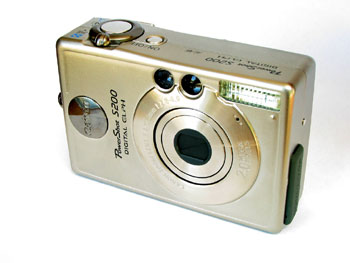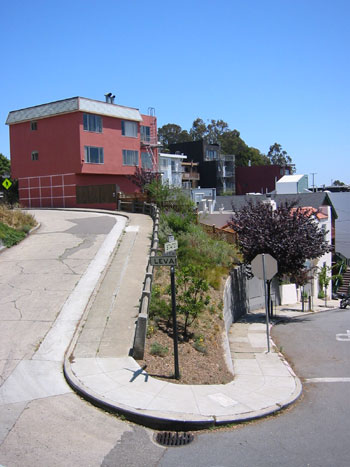Something Elph: Canon’s S200 Packs Big Features into Tiny Camera
When Canon released the PowerShot S100 Digital Elph a few years ago, it stood alone in the category of “tiny, high-quality digital cameras.” Then came stiff competition in the form of excellent small cameras from Sony and Nikon (especially the Nikon CoolPix 2500), and the Elph was no longer the obvious small-camera choice that it once was. Fortunately, Canon recently shored up its place in the market with the release of the S200 Digital Elph, the first major upgrade to the original S100.
Like its predecessor, the 2-megapixel S200 is the length and width of a credit card, but the new model is slightly thinner, measuring a little less than an inch thick (see figure 1). Sporting the same all-metal body as the earlier model, the S200 is one of the sturdiest digital cameras you’ll find. At the same time, its compact, slab-like design makes it much easier to pocket than competitors that have protruding lenses or molded handgrips. The design and feel of the S100 was one of its strong points and Canon has not abandoned those aesthetics in this upgrade. Though it may be a little thinner, the S200 camera still feels sturdier than all of its tiny competitors – an important point in a camera that is meant to be tucked in a pocket or handbag.

Figure 1: Canon’s S200 Digital Elph is less than an inch thick but feels sturdy in the hand.
To be fair, Canon did release the S105 a few years ago, a minor upgrade that added the capability to shoot QuickTime movies along with some slight image-quality tweaks, but it was definitely behind the curve when compared with the feature sets of its latest competitors.
Super-Slow ISO
With the S200 Canon has addressed all of these deficiencies, and then some. The S200 now provides multiple ISO ratings of 100, 200, and 400, as well as the same super-slow ISO 50 of the Canon G2. Lack of adjustable ISO was our biggest complaint with the S100, but the addition of the super-smooth, low-noise ISO 50 is more than we expected and happily so. Higher ISOs allow for shooting in lower-light situations without having to resort to using the camera’s built-in flash, while lower ISOs are best for brightly lit scenes.
As one would expect, at higher ISOs, the S200’s images get markedly noisier, but the faster speeds show a much nicer type of noise than some of Canon’s other cameras, including the high-end G2. The S200’s ISO 400, while grainy, lacks the bright-color, noisy specks of other Canon cameras, and as a result is a bit more usable because of it. The slower, ISO 50 allows you to shoot in bright light with very little visible noise, resulting in smoother images than competing cameras.


Figure 2: Overall the S200 delivers very good color with excellent contrast and saturation. The extra-slow ISO 50 yields daylight images with practically no visible noise (top). Overall, we found its image quality to be superior to the Nikon Coolpix 2500 (bottom), its chief small-camera competitor.
Plainly, the S200 has benefited from technologies and software that Canon has developed for other models, and the new Elph packs features that we never would have expected to see in a tiny point-and-shoot camera. Among these are: multiple focus spots, histogram display, full manual white balance, and spot metering. Other new features include separate focus and exposure locks, which allow you to create more complex framings and handle difficult lighting situations, and a Flash Exposure lock, which lets you control flash exposure by metering off of a particular part of your image.
Obviously, these features are far beyond the requirements of the typical snapshot taker, but for the more serious photographer, they provide a great deal of power in a tiny package, and they allow for much more creative control when shooting under tricky conditions.
The Elph still does not have any manual exposure options beyond the basic exposure compensation controls. If you were hoping for shutter or aperture priority, or a full manual mode, then you’re out of luck. However, the two stops of exposure compensation should get you through most of your exposure needs.
The S200 preserves all of the features of the S105, including an excellent panoramic assist mode, and ability to shoot QuickTime movies with sound, though the camera still lacks a speaker for hearing audio on playback. No surprise in a camera this small.
The Elph’s performance is hard to beat. Boot time is roughly 2.5 seconds meaning this camera is ready to shoot when you are. Shutter lag is imperceptible and switching from record mode to playback is very speedy, while the camera’s 2-megapixel resolution means writing files is quick and painless. Overall, we have no complaints about the speed of any of the camera’s operations.
New Interface
Canon has thoroughly re-worked the camera’s interface, with the main change being the addition of a four-way button pad on the back of the camera. This, along with the four buttons included beneath the unit’s LCD screen, provide single button access to white balance, exposure compensation, spot metering, flash modes, macro and infinity modes, burst shooting, and the self-timer.
Canon has made some other nice interface changes such as the addition of an automatic image review (you used to have to hold down the shutter button after shooting to see an image review) but some of the camera’s menu options are still a little difficult to manage. Selecting a shooting mode and image size is still not intuitive.
The S200 keeps the same 2-megapixel resolution as its forebears, putting it in line with most of its small-camera competition. The camera’s image quality is very good, and the new camera can definitely deliver better images than its predecessor, though this is largely due to the addition of the low-noise ISO 50 mode.
For the S200, Canon has upgraded the S100’s battery with a newer model that charges slightly faster and has slightly improved capacity. The battery and external charger are included in the box, along with a USB cable and video cable for attaching the camera to your TV. The camera ships with an 8MB CompactFlash card, but you’ll want to upgrade. A 32MB card should hold about 50 high-quality (1600×1200 pixels) images. Two other image modes are available: 1024×768 pixels (Medium) and 640×480 pixels (Small).
Conclusion
If small size is important to you, then the S200 Digital Elph is the camera to buy. Smaller than the Sony P71and any of the Nikon offerings, the camera is sturdier than any of its competition. While Sony and Nikon’s cameras offer image quality on par with the Elph’s, Canon scores with better ergonomics, better design, and a full feature set.
In the realm of tiny, high-quality digital cameras, the Elph is again a big deal.
Read more by Ben Long.


